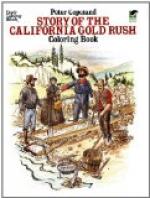Nearly thirty years ago Mr. Tibbets came from New York to this state and took up free government land near what is now the beautiful city of Riverside. He was one of the half-dozen pioneer fruit-growers of that region, and had noticed at the San Gabriel Mission how well orange trees grew there. His wife and daughter waited in Washington, D.C., until a home should be ready here for them, and they often sent Mr. Tibbets plants and seeds from the Department of Agriculture. To this Department and its gardens in Washington, many curious plants are forwarded from other countries for growing and experiment in the United States. New kinds of grain or fruits are carefully cultivated and watched by the Department, and from it farmers can always get seeds or cuttings to try on their own farms.
Mrs. Tibbets often visited the Department gardens, and in 1873 she wrote to her husband that she could get him some fine orange trees if he would promise the government to take great care of them and to keep them apart from other trees till they fruited. Of course he agreed to give them special attention, and therefore that December he received three small, rooted orange trees. A cow chewed up one of these, but for five years the others were watched and tended. Then sweet white blossoms appeared on each little tree, and afterwards two oranges, like hard green bullets at first. Finally, in January, 1879, Mr. Tibbets picked four large, well-flavored, golden oranges, the first seedless ones ever grown outside of Brazil.
From the hot swamps of the tropical country at Bahia the United States Consul had sent six cuttings of this peculiar orange to be planted in the Washington gardens. All died but the two at Riverside. In 1880 they bore half a bushel of fruit, and the new seedless oranges were talked of throughout Southern California. The other orange growers had been cultivating “seedlings,” trees which bore smaller fruit, with many bitter seeds and a thick skin. Many of these growers now cut back their seedlings to bare limbs, and grafted the new orange on these branches. This is called “budding,” and is done by cutting off a thin slip of bark with a tiny folded-up leaf-bud on it, inserting the graft in the branch to be budded and securing it there with wax to keep the air out. The little bud drinks in sap from the tree stem, and grows and blossoms true to its own mother tree.
There were few orange groves then, but soon nearly all were budded to the new kind, seventy-five acres being so changed on the Baldwin Ranch; and when these trees began to bear, some five years afterwards, people were much excited over the seedless fruit.




